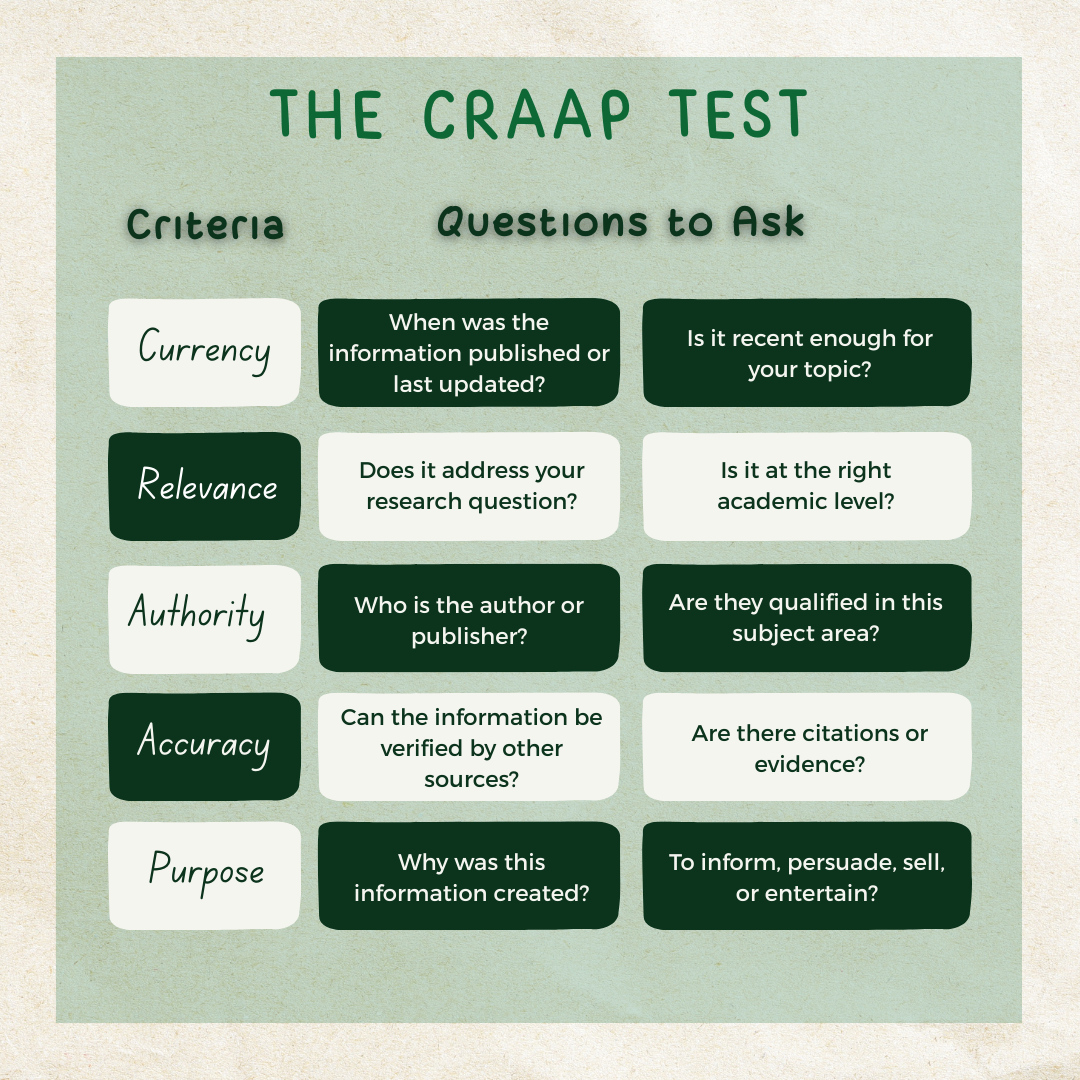
Evaluating Resources: A Step-by-Step Guide
When conducting research, not all sources are created equal. The quality, reliability, and purpose of the materials you use can greatly impact your work. Evaluating sources is a critical step in the research process because it helps you determine whether the information you’ve found is trustworthy, accurate, and appropriate for your needs.
This guide will walk you through key criteria for evaluating resources, highlight the differences between scholarly and popular sources, and provide strategies to help you choose the most credible materials for your assignments and projects. By learning how to evaluate sources effectively, you’ll strengthen your research and build a solid foundation for your academic work.
In this guide we will be covering:
The CRAAP Test
The SIFT Method
Scholarly vs. Popular sources
How to recognize bias
Fact checking and Cross-referencing
Evaluating online sources
The CRAAP Test
The CRAAP Test is a helpful checklist for evaluating the reliability and usefulness of information. Each letter in CRAAP stands for a key area to consider when deciding whether a source is credible and appropriate for your research.
Use the CRAAP Method Worksheet to help you evaluate sources!
C - Currency
Ask: Is the information up-to-date?
Why it matters: Some topics (like technology, medicine, or current events) require very recent information. Others (like history or literature) may rely on older sources.
How to check:
Look for the publication date.
Ask if the information has been revised or updated.
Consider if newer research or data is available.
R – Relevance
Ask: Does this source meet my research needs?
Why it matters: A source can be credible, but not useful if it doesn’t directly connect to your research question.
How to check:
Determine if the content is at an appropriate level (not too basic, not too advanced).
Check if the source covers your specific research angle.
Consider if the source adds something unique to your understanding.
A – Authority
Ask: Who is the author, and are they qualified?
Why it matters: The credibility of a source depends heavily on the expertise of its creator.
How to check:
Look for the author’s credentials, background, or professional affiliation.
Check if the publisher or sponsoring organization is reputable.
Be cautious of anonymous or unclear authorship.
A – Accuracy
Ask: Is the information reliable and correct?
Why it matters: Incorrect or misleading information can weaken your research.
How to check:
Verify facts by cross-checking with other credible sources.
Look for citations, references, and evidence supporting claims.
Check for bias or emotional language that might distort facts.
P – Purpose
Ask: Why was this information created?
Why it matters: Understanding the intent behind a source helps you spot potential bias.
How to check:
Determine if the goal is to inform, persuade, entertain, or sell something.
Watch out for overly opinionated content or hidden agendas.
Consider whether the source provides a balanced view or only one perspective.
The SIFT Method
The SIFT Method, a simple strategy designed to help you quickly decide whether a source can be trusted:
Stop – Pause and ask yourself if you know the source and its reputation.
Investigate the source – Look into who created it and why.
Find better coverage – Check if other reliable sources are saying the same thing.
Trace claims and quotes – Follow citations back to their original context.
Using the SIFT method, along with understanding the differences between scholarly and popular sources, will help you build a strong foundation of credible, high-quality information for your research.
Vanderbilt Libraries Teaching & Learning - Using SIFT to Evaluate Sources for Credibility Tutorial
Scholarly vs Popular Sources
When starting research, it’s important to understand the difference between scholarly and popular sources. Scholarly sources, such as peer-reviewed journal articles, are written by experts and intended for an academic or professional audience. They provide in-depth analysis, cite evidence, and contribute to ongoing scholarly conversations. Popular sources, such as newspapers, magazines, or blogs, are created for a general audience and are designed to inform, entertain, or persuade rather than to advance research.
Knowing how to tell these types of sources apart will help you choose the most reliable and appropriate information for your assignments.
Use the table to help you distinguish between scholarly and popular sources:
| Feature | Scholarly Sources | Popular Sources |
|---|---|---|
| Author | Written by experts, researchers, or scholars (credentials provided). | Written by journalists, staff writers, or enthusiasts (credentials may be limited). |
| Audience | Researchers, students, professionals. | General public. |
| Language | Technical, discipline-specific terminology. | Everyday, non-technical language. |
| References | Includes citations, footnotes, and bibliographies. | Rarely includes formal references. |
| Publisher | Academic presses or professional associations. | Commercial publishers, magazines, news outlets. |
| Review Process | Peer-reviewed by subject experts. | Editor-reviewed (not peer-reviewed). |
| Visuals & Ads | Graphs, charts, data; few or no ads. | Photos, illustrations; frequent advertisements. |
| Examples | Journal of Library Research, Nature | Time, National Geographic, The New York Times |
Recognizing Bias in Sources
What is Bias?
Bias is when information is presented in a way that favors one perspective, opinion, or outcome over others—sometimes unintentionally, but often in a way that can distort facts or limit understanding. In research, bias matters because it can affect how reliable and balanced a source is.
All sources have a point of view, but in academic research you need to watch out for strong bias that can distort facts or mislead readers.
Remember: A biased source isn’t automatically “bad.” It can still be useful—but only if you recognize the bias and balance it with more neutral, scholarly sources.
How to Spot Bias
Ask yourself:
Language and Tone:
Does the author use loaded or emotional words (e.g., outrageous, disaster, brilliant)?
Or is the tone neutral and professional?
Evidence and Support:
Are claims backed up with reliable data and references?
Or is the source mostly opinion without evidence?
Balance of Perspectives:
Does the source consider multiple sides of the issue?
Or does it present only one side as “correct”?
What’s Missing?:
Are important facts or viewpoints left out?
Could leaving this information out change how you understand the topic?
Author and Publisher:
Who created this source?
Do they have a political, commercial, or personal interest in shaping your opinion?
HGTC Reference Librarians - Recognizing Bias in Sources
Fact Checking & Cross Referencing
When evaluating sources, it’s important to verify the accuracy of the information you find. Two closely related but distinct strategies are fact-checking and cross-referencing. Both help ensure that your research is based on reliable, credible information.
Fact-Checking
Definition: Fact-checking is the process of verifying specific claims, statistics, or statements made in a source to determine whether they are true or accurate.
Why it’s important:
Prevents the spread of misinformation or false claims.
Ensures that your research is grounded in accurate, trustworthy data.
Helps you maintain credibility in your own writing and arguments.
How to fact-check:
Identify the key claim or piece of information you want to verify.
Look for reputable sources that directly support or refute the claim.
Use government websites (.gov), educational sites (.edu), and well-known organizations.
Check multiple authoritative sources to confirm the accuracy of the information.
Use dedicated fact-checking websites when appropriate (e.g., Snopes, FactCheck.org).
Cross-Referencing
Definition: Cross-referencing is the process of comparing information across multiple sources to see if they agree, differ, or provide additional context.
Why it’s important:
Helps you understand the broader context and complexity of a topic.
Reveals potential biases or gaps in a single source.
Strengthens the reliability of your research by showing consensus or patterns in the literature.
How to cross-reference:
Identify a claim, data point, or piece of information.
Look for additional sources discussing the same topic or fact.
Compare how different sources report the information.
Are the numbers consistent?
Do authors interpret results in the same way?
Note any discrepancies or different perspectives and consider how they affect your research.
| Strategy | Focus | Purpose |
|---|---|---|
| Fact-Checking | Individual claim, statistic, or statement | Verify accuracy of a specific piece of information |
| Cross-Referencing | Comparing multiple sources | Evaluate consistency, context, and reliability across sources |
Fact-Checking vs. Cross-Referencing
Evaluating Online Sources
The internet is a vast resource, but not everything you find online is accurate, credible, or suitable for academic research. Evaluating online sources requires a critical eye and careful consideration of who created the content, why it was created, and how reliable it is.
Key Considerations
1. Check the Domain
Domains can give clues about a website’s reliability:
.edu – educational institutions (usually credible for research)
.gov – government websites (reliable for statistics, laws, policies)
.org – non-profit organizations (can be reliable, but check for bias)
.com – commercial sites (may have promotional or sales agendas)
Remember: a trustworthy domain does not guarantee accurate content.
2. Investigate the Author or Organization
Look for an “About” page or author credentials.
Check for expertise, affiliation, or experience in the topic area.
Consider whether the organization or author might have a vested interest in the information presented.
3. Purpose and Audience
Ask why the content exists: to inform, persuade, sell, or entertain?
Consider who the intended audience is and how that might shape the tone, depth, or bias of the information.
4. Accuracy and Evidence
Look for citations, references, or links to original sources.
Cross-check information with other credible websites or databases.
Be wary of statistics or quotes without clear sourcing.
5. Currency
Check the publication or last updated date.
Ensure the information is current enough for your research topic. Some topics, like technology or healthcare, require up-to-date sources.
6. Signs of Bias or Misleading Information
Watch for emotionally charged language or extreme opinions.
Evaluate whether opposing perspectives are presented fairly.
Identify potential conflicts of interest, such as sponsorships or advertising influence.
Quick Tips for Online Research
Use library databases whenever possible; they provide curated, credible content.
Avoid relying solely on search engines like Google for academic research.
Verify social media or user-generated content carefully. Check for original sources, dates, and author credentials.
Combine fact-checking, cross-referencing, and the SIFT method to evaluate unfamiliar websites.
Tip: Even reliable online sources should be evaluated carefully. Combining domain checks, author investigation, bias recognition, and fact verification ensures you are using credible, accurate, and useful information for your research.


